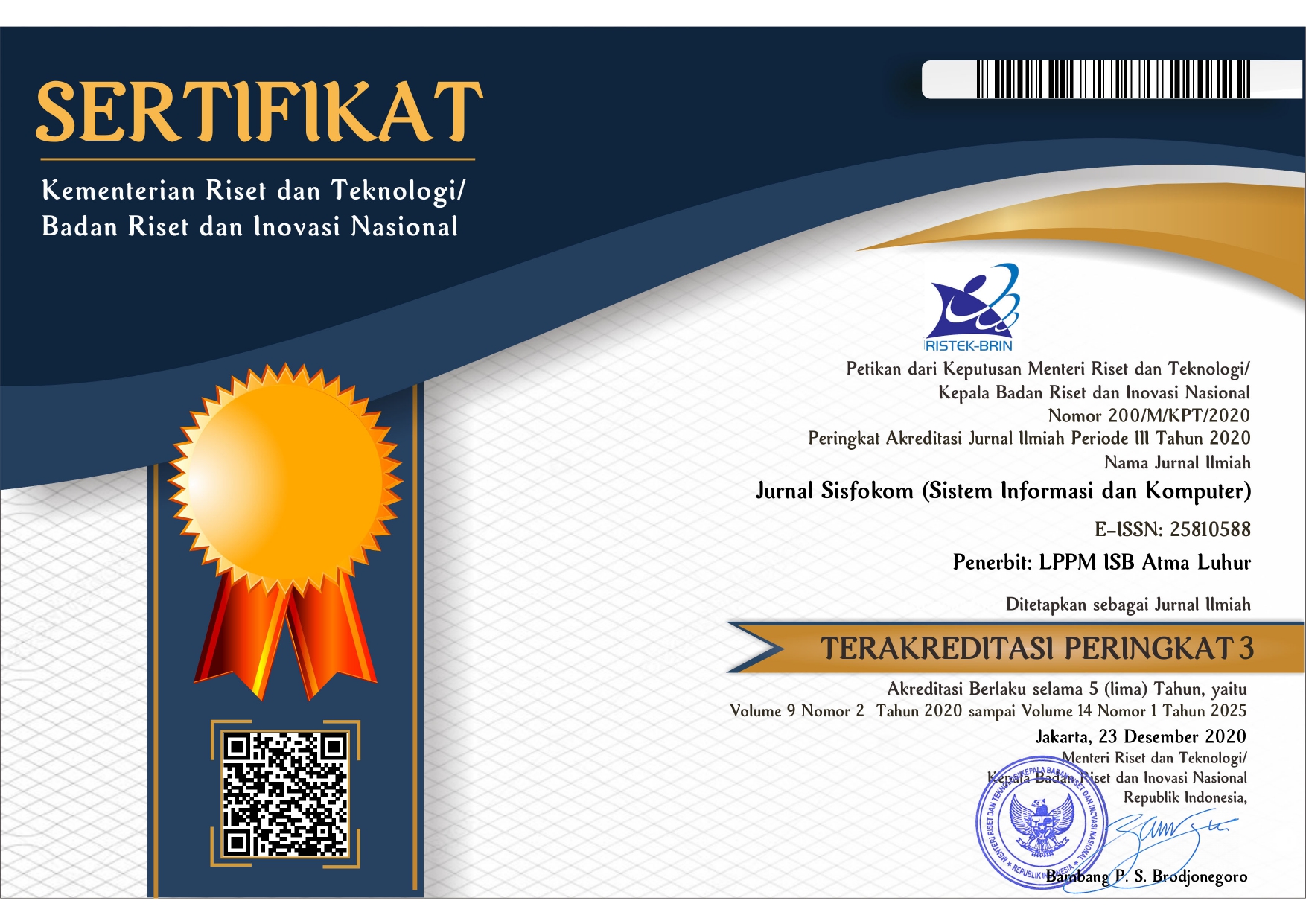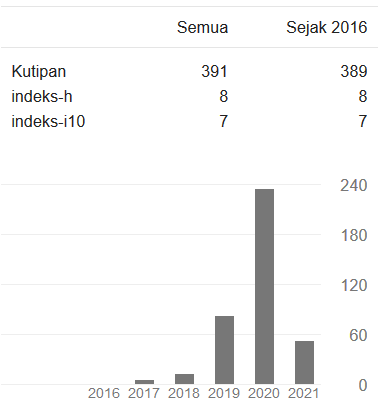Application of the Technology Readiness Index to Measure the Readiness of Personnel Information Systems for Village Employees in Tanjungmedar District
DOI:
https://doi.org/10.32736/sisfokom.v14i3.2378Keywords:
Technology Readiness Index, Information System, Village Apparatus.Abstract
The development of information technology encourages village governments to adopt digital systems in improving services, including in the field of staffing. However, the readiness of village officials in using this information system is often a major challenge. This study aims to measure the level of readiness of village officials in Tanjungmedar District in adopting a personnel information system using the Technology Readiness Index (TRI) model. This model analyzes four psychological dimensions, namely optimism, innovativeness, discomfort, and insecurity. The study involved all village officials in nine villages in Tanjungmedar District with a total of 96 respondents. Data were collected through a Likert scale-based questionnaire and analyzed using validity, reliability, and TRI calculations. The research results showed a total TRI score of 3.38, which falls into the medium readiness index category. The variables of optimism and innovation received high scores, 1.02 and 1.03 respectively, while discomfort and insecurity scored lower, at 0.66 and 0.68. The research results indicate the need to improve aspects of comfort and security in the use of the information system. As a recommendation, technical training and system improvements are suggested to support optimal adaptation of information technology.References
Komdigi, “Kementerian Komunikasi dan Digital.” Accessed: Oct. 25, 2024. [Online]. Available: https://www.komdigi.go.id/transformasi-digital/pemerintahan-digital
M. Mayadi and P. Kustanto, “Pelatihan Sistem Informasi Pelayanan Surat Pengantar Untuk Perangkat Desa Mangunjaya Kecamatan Tambun Selatan Kabupaten Bekasi,” J. Pengabdi. Kpd. Masy. UBJ, vol. 5, no. 1, pp. 11–22, Aug. 2024, doi: 10.31599/qyn62248.
S. Hartati, “Pendampingan Pemutakhiran Data Kependudukan pada E-Office Desa sebagai Upaya Mewujudkan Tertib Administrasi Kependudukan di Desa Cibeusi Kecamatan Jatinangor, Sumedang, Jawa Barat,” Civ. Consecratio J. Community Serv. Empower., vol. 2, no. 2, pp. 81–93, Feb. 2023, doi: 10.33701/cc.v2i2.2729.
M. A. Lestari, M. Tabrani, and S. Ayumida, “Sistem Informasi Pengolahan Data Administrasi Kependudukan Pada Kantor Desa Pucung Karawang,” J. Interkom J. Publ. Ilm. Bid. Teknol. Inf. Dan Komun., vol. 13, no. 3, pp. 14–21, Oct. 2018, doi: 10.35969/interkom.v13i3.33.
A. Sandi, “E-Office Diterapkan, Perangkat Desa Malas Siap-siap Kena Sanksi,” korsum.id. Accessed: Nov. 04, 2025. [Online]. Available: https://www.korsum.id/e-office-diterapkan-perangkat-desa-malas-siap-siap-kena-sanksi/
S. Rosyad and M. Harsono, “Pentingnya Perceived Usefulness Dan Perceived Ease of Use: Dalam Teknologi Informasi,” J. Ilm. Ilmu Terap., vol. 5, no. 1, pp. 86–92, 2021, doi: https://doi.org/10.22437/jiituj.v5i1.13723.
A. Parasuraman, “Technology Readiness Index (Tri): A Multiple-Item Scale to Measure Readiness to Embrace New Technologies,” J. Serv. Res., vol. 2, no. 4, pp. 307–320, May 2000, doi: 10.1177/109467050024001.
S. Bharatula and B. S. Murthy, “Digital Readiness Index—Empowering the Nation,” in ICT Analysis and Applications, vol. 93, S. Fong, N. Dey, and A. Joshi, Eds., in Lecture Notes in Networks and Systems, vol. 93. , Singapore: Springer Singapore, 2020, pp. 209–216. doi: 10.1007/978-981-15-0630-7_20.
F. Ahmad, E. Pudjiarti, and E. P. Sari, “Penerapan Metode Technology Readiness Index Untuk Mengukur Tingkat Kesiapan Anak Sekolah Dasar Melakukan Pembelajaran Berbasis Online Pada SD Muhammadiyah 09 Plus,” JTIM J. Teknol. Inf. Dan Multimed., vol. 3, no. 1, pp. 21–31, May 2021, doi: 10.35746/jtim.v3i1.126.
M. K. Anam, F. Zoromi, Soni, T. Nasution, and K. Andesa, “Penerapan Model Technology Readiness Index untuk Mengukur Tingkat Kesiapan Mahasiswa dalam Penerimaan Sistem E-Polvot,” J. Teknol. Inf. Dan Ilmu Komput., vol. 10, no. 6, pp. 1401–1408, Dec. 2023, doi: 10.25126/jtiik.1067368.
I. Shofwan, E. Witcahyo, and Y. T. Herawati, “Analisis Kesiapan Pengguna dan Pengaruhnya terhadap Penerimaan SIK Lumajang sebagai Sistem Informasi Manajemen Puskesmas,” J. Kedokt. Dan Kesehat., vol. 14, no. 1, p. 83, Mar. 2018, doi: 10.24853/jkk.14.1.83-97.
F. M. Dzulkifli, E. D. Wahyuni, and G. W. Wicaksono, “Analisis Kesiapan Pengguna Lective Menggunakan Metode Technology Readiness Index (TRI),” J. Repos., vol. 2, no. 7, Jan. 2024, doi: 10.22219/repositor.v2i7.30747.
W. H. Putri, S. A. T. Novia, and Nurwiyanta, “E-Wallet in Technology Readiness Index Perspectives and Technical Support:,” presented at the The 3rd International Conference on Banking, Accounting, Management and Economics (ICOBAME 2020), Semarang, Indonesia, 2020. doi: 10.2991/aebmr.k.210311.063.
A. N. Rahmadini, E. Yulianingsih, I. Z. Yadi, and R. Amalia, “Analisis Pengukuran Kesiapan Pengguna Website SIKN di Dinas Kearsipan Provinsi Sumatera Selatan Menggunakan Metode Technology Readiness Index (TRI),” J. Teknol. Inform. Dan Komput., vol. 9, no. 2, pp. 1235–1246, Sep. 2023, doi: 10.37012/jtik.v9i2.1797.
S. N. Saripah, F. Mahardika, and D. Santika, “EVALUATION OF SCHOOL PAYMENT APPLICATION USER READINESS USING THE TECHNOLOGY READINESS INDEX (TRI) METHOD,” JOCSIT J. Collab. Sci. Inform. Technol., vol. 1, no. 1, pp. 12–27, Jun. 2024, doi: 10.69933/jocsit.v1i1.62.
A. M. Zakiyyah and U. A. Rosyidah, “Analisis Technology Readiness Sebagai Upaya Mitigasi Teknologi Pada Umkm Di Jember,” JUSTINDO J. Sist. Dan Teknol. Inf. Indones., vol. 7, no. 1, pp. 42–49, Mar. 2022, doi: 10.32528/justindo.v7i1.4974.
B. Warsuta, A. T. Muharram, I. Yusdisti, and S. A. Jasmine, “Pengukuran Tingkat Kesiapan Implementasi E-Learning di Politeknik Negeri Jakarta,” J. Teknol. Terpadu, vol. 7, no. 2, pp. 93–97, Dec. 2021, doi: 10.54914/jtt.v7i2.434.
N. K. Ismatullah, R. Chairunnisah, and H. Andriani, “Technology Readiness and Acceptance Model: Analisis Kesiapan Pengguna dalam Penerapan Rekam Medis Elektronik di RSUD Provinsi NTB,” J. Manaj. Inf. Kesehat. Indones., vol. 13, no. 1, Art. no. 1, Mar. 2025, doi: 10.33560/jmiki.v13i1.756.
A. K. Darmawan, M. Muhsi, M. W. Al Wajieh, M. B. Setyawan, A. Komarudin, and F. Ariyanto, “Predicting Smart Regency Readiness on Sub-Urban Area in Indonesia: A perspective of Technology Readiness Index 2.0,” in 2022 International Conference on ICT for Smart Society (ICISS), Bandung, Indonesia: IEEE, Aug. 2022, pp. 01–06. doi: 10.1109/ICISS55894.2022.9915246.
I. Rozak, R. Johari, A. Musyaffi, R. Marota, and M. Arinal, “E-Government Finance System Readiness for Village Government Employees: Lessons from Indonesia,” Qual. - Access Success, vol. 23, pp. 238–244, Aug. 2022, doi: 10.47750/QAS/23.189.27.
Aditianto, Murhadi, and H. M. Jumasa, “Analisis Tingkat Kesiapan Pemanfaatan Sistem Informasi Desa Di Desa Kedungpomahan Wetan Purworejo,” INTEK J. Inform. Dan Teknol. Inf., vol. 7, no. 2, pp. 18–25, Nov. 2024, doi: 10.37729/intek.v7i2.5321.
T. Handayani and S. Sudiana, “ANALISIS PENERAPAN MODEL UTAUT (UNIFIED THEORY OF ACCEPTANCE AND USE OF TECHNOLOGY) TERHADAP PERILAKU PENGGUNA SISTEM INFORMASI (STUDI KASUS: SISTEM INFORMASI AKADEMIK PADA STTNAS YOGYAKARTA),” Angkasa J. Ilm. Bid. Teknol., vol. 7, no. 2, p. 165, Sep. 2017, doi: 10.28989/angkasa.v7i2.159.
Riduwan, BELAJAR MUDAH PENELITIAN, 9th ed. Bandung: ALFABETA, 2013.
S. Arikunto, Prosedur Penelitian : Suatu Pendekatan Praktik (Edisi Revisi). Jakarta: Rineka Cipta, Jakarta, 2013.
Sugiyono, Metode Penelitian Kuantitatif Kualitatif, dan R&D. Bandung: ALFABETA, Bandung, 2017.
Sugiyono, Metode Penelitian Administrasi Dilengkapi dengan Metode R&D. 2012.
S. Erlinda, M. K. Anam, T. Nasution, A. Ambiyar, and D. Irfan, “ANALISIS TINGKAT OBJEKTIFITAS PENGISIAN EDOM UNTUK MENINGKATKAN KUALITAS PEMBELAJARAN DOSEN,” JURTEKSI J. Teknol. Dan Sist. Inf., vol. 7, no. 1, pp. 107–116, Dec. 2020, doi: 10.33330/jurteksi.v7i1.881.
J. C. Nunnally, “An Overview of Psychological Measurement,” in Clinical Diagnosis of Mental Disorders, B. B. Wolman, Ed., Boston, MA: Springer US, 1978, pp. 97–146. doi: 10.1007/978-1-4684-2490-4_4.
M. Tavakol and R. Dennick, “Making sense of Cronbach’s alpha,” Int. J. Med. Educ., vol. 2, pp. 53–55, Jun. 2011, doi: 10.5116/ijme.4dfb.8dfd.
Downloads
Published
Issue
Section
License
Copyright (c) 2025 Agun Guntara, Irfan Fadil, Fidi Supriadi, Aa Agus Mulyana

This work is licensed under a Creative Commons Attribution 4.0 International License.
The copyright of the article that accepted for publication shall be assigned to Jurnal Sisfokom (Sistem Informasi dan Komputer) and LPPM ISB Atma Luhur as the publisher of the journal. Copyright includes the right to reproduce and deliver the article in all form and media, including reprints, photographs, microfilms, and any other similar reproductions, as well as translations.
Jurnal Sisfokom (Sistem Informasi dan Komputer), LPPM ISB Atma Luhur, and the Editors make every effort to ensure that no wrong or misleading data, opinions or statements be published in the journal. In any way, the contents of the articles and advertisements published in Jurnal Sisfokom (Sistem Informasi dan Komputer) are the sole and exclusive responsibility of their respective authors.
Jurnal Sisfokom (Sistem Informasi dan Komputer) has full publishing rights to the published articles. Authors are allowed to distribute articles that have been published by sharing the link or DOI of the article. Authors are allowed to use their articles for legal purposes deemed necessary without the written permission of the journal with the initial publication notification from the Jurnal Sisfokom (Sistem Informasi dan Komputer).
The Copyright Transfer Form can be downloaded [Copyright Transfer Form Jurnal Sisfokom (Sistem Informasi dan Komputer).
This agreement is to be signed by at least one of the authors who have obtained the assent of the co-author(s). After submission of this agreement signed by the corresponding author, changes of authorship or in the order of the authors listed will not be accepted. The copyright form should be signed originally, and send it to the Editorial in the form of scanned document to sisfokom@atmaluhur.ac.id.









